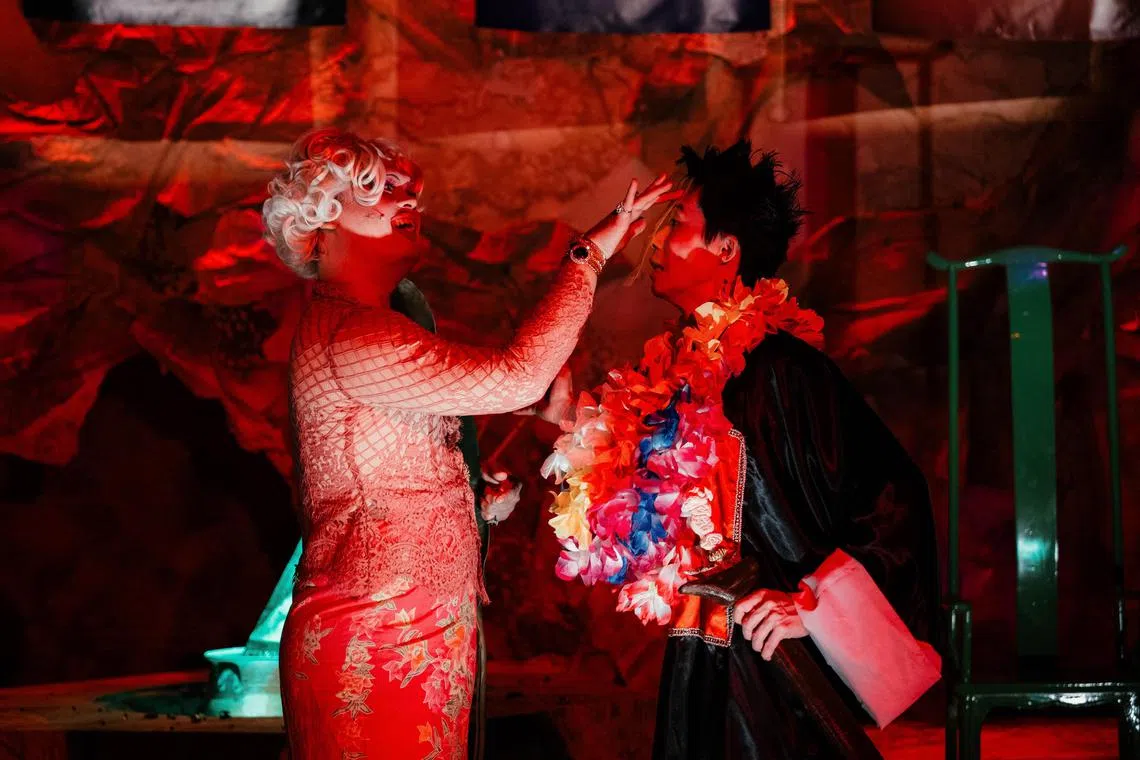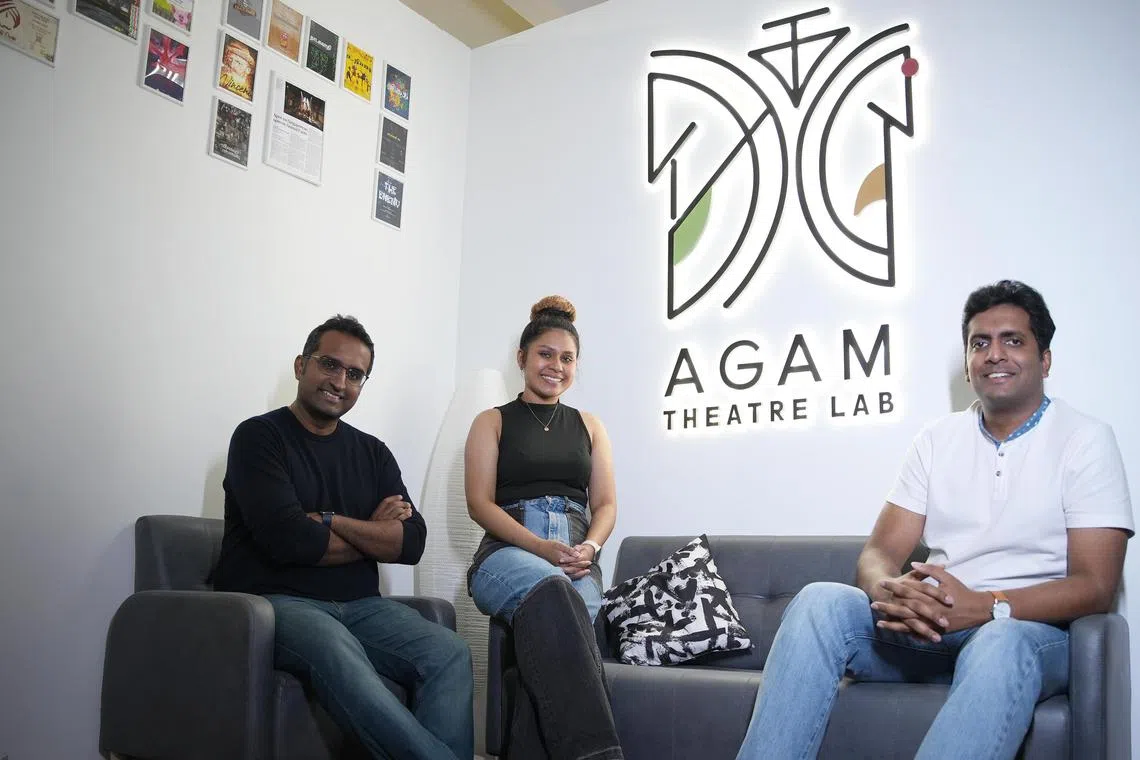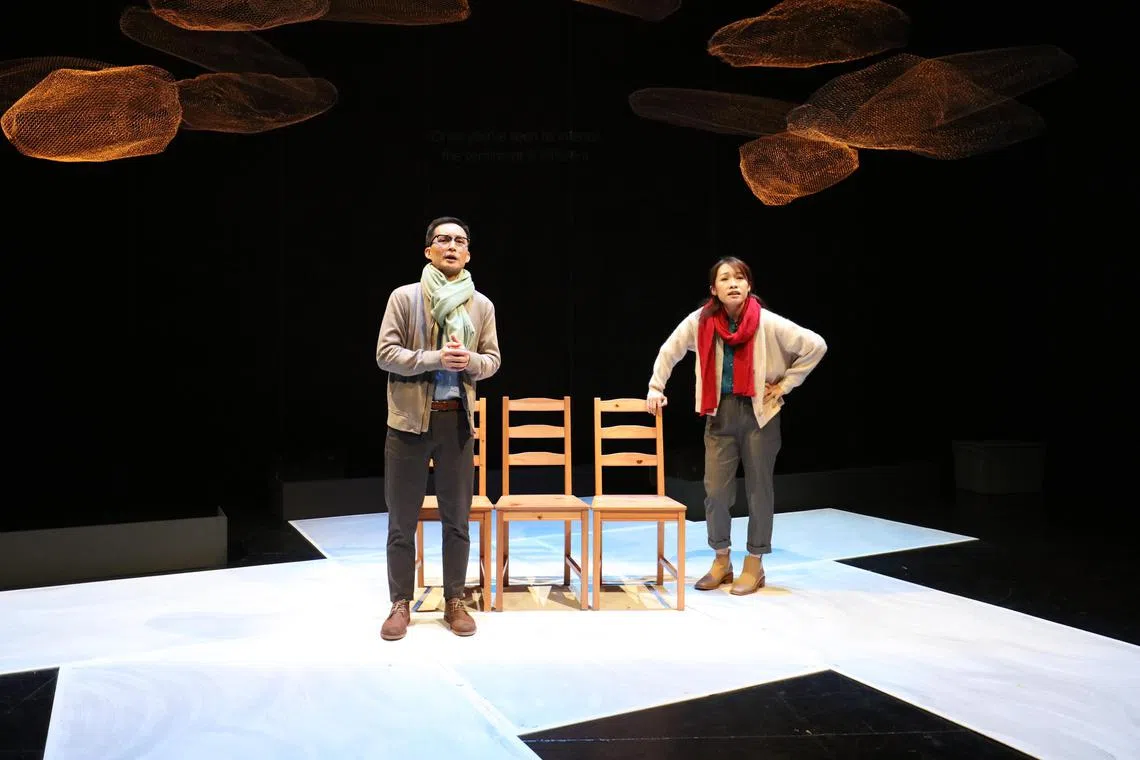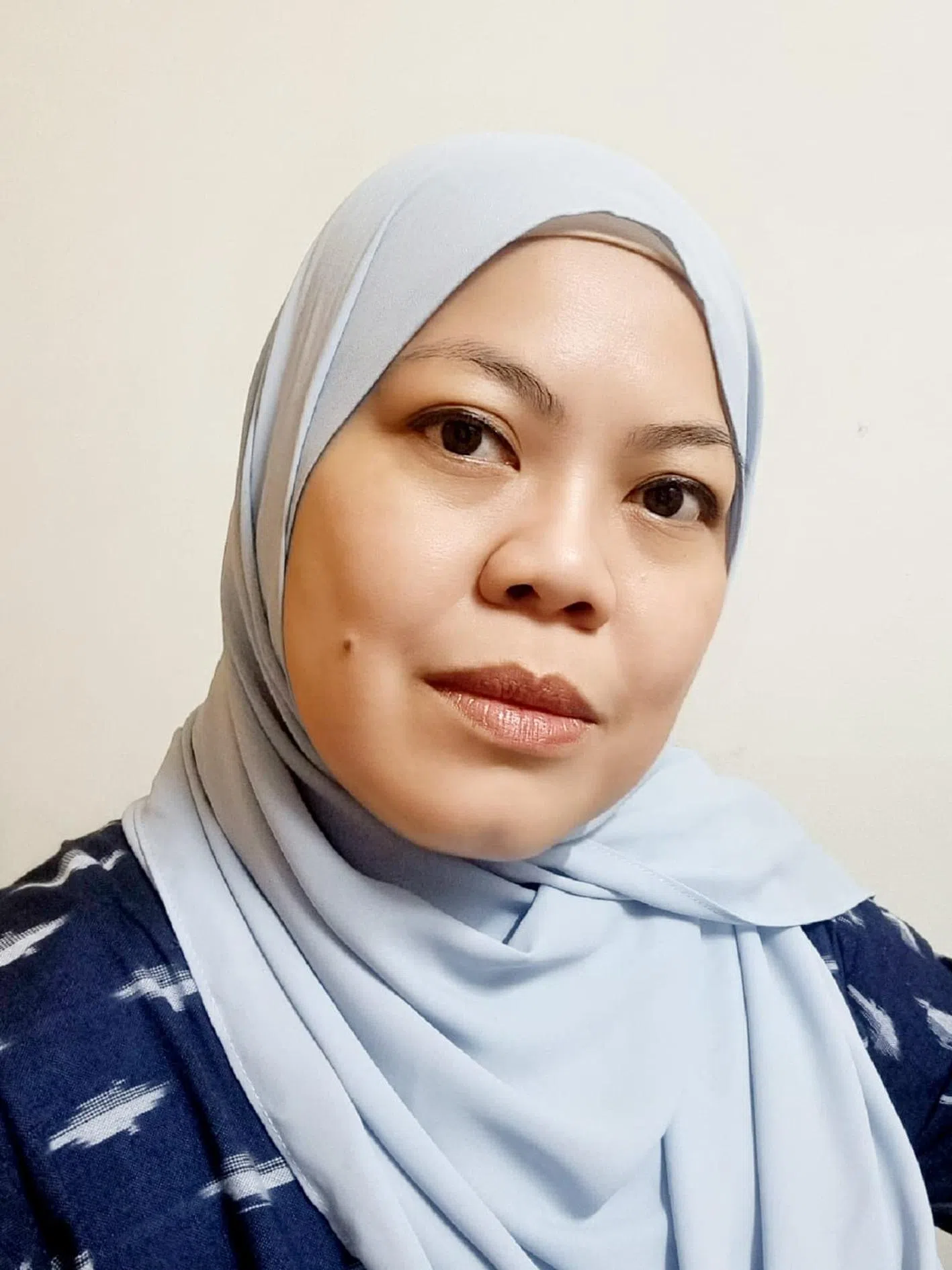Mother-tongue theatre draws younger audiences despite funding challenges and other obstacles
Sign up now: Get ST's newsletters delivered to your inbox

Home-grown Tamil theatre company Agam Theatre Lab’s Vilangkuppannai was watched by 800 people over four shows.
PHOTO: AGAM THEATRE LAB
Follow topic:
SINGAPORE – Think of mother-tongue theatre, and one’s first instinct might be to reach for the language of atrophy and demise. But this would be very much a mistake, with plays in Mandarin, Malay and Tamil having a moment in 2022.
Whether they were family drama, classic remakes or supernatural satire, they played to full-house audiences and attracted more diverse crowds, riding on a wave of interest as pandemic restrictions were loosened and theatre came back with a vengeance.
Malay-language group Teater Ekamatra saw its programmes and productions attended by more than 5,000 people in 2022 – the highest number in its 34-year history.
It put on three sold-out shows in 2022 and its incoming artistic director Shaza Ishak
New kid on the block Agam Theatre Lab’s Vilangkuppannai, or Animal Farm, also managed four shows in a booked-out Esplanade Theatre Studio. A total of 800 people saw the Tamil adaptation of the Orwellian fable by literary pioneer P. Krishnan in June.
These are solid numbers – particularly for a Tamil company which was founded only in 2019, and had used much of the pandemic to settle itself through virtual and hybrid programmes.
Theatre companies say that amid the ubiquity of streaming services like Netflix, the inclusion of more international shows on these platforms appears to have cultivated a hyper-curious younger audience more open to reading subtitles and surtitles.
There may also be a gradual turn from the international towards the local, with mother-tongue plays better placed to speak to Singaporeans’ multilingual existence, which has stayed resilient despite the increasing number of households using English as their first language.
Shaza adds: “Our shows, and attending them, are a way of resisting cultural homogenisation, a way of feeling acknowledged, a way of challenging the status quo.”
Only about half of Teater Ekamatra’s audience is Malay. “The quality of our work, our voice, is more important.”

Wild Rice Singapore’s Make Hantus Great Again starred (from left) Hafidz Rahman and Neo Hai Bin.
PHOTO: A. SYADIQ
Nelson Chia, co-founder of Chinese theatre company Nine Years Theatre, has also seen a more diverse crowd of late.
Between You And Me, Nine Years’ offering during the 2022 Huayi – Chinese Festival of Arts, starred familiar faces such as Goh Guat Kian and Sharon Au, and played six shows at the nearly 2,000-seat Esplanade Theatre to mostly sold-out crowds.
“They come in to watch our play because we put on good productions,” he says. “The Chinese language is still very beautiful.
“When we talk about multiculturalism, we have to look at the prefix ‘multi’ first. It means ‘many’, and audiences enjoy seeing us negotiating with others on the scene in a very colourful way.”
Before the turn of the century, it was common for mother-tongue theatre companies to put on huge shows in grand venues like the Victoria Theatre.
That heyday is now firmly over, and smaller black-box venues are more likely. But mother-tongue practitioners are hoping that they have successfully arrested the downturn and even begun a slow reversal.
Increases in their audience numbers have been hard won. In recent years, mother-tongue theatre companies have paid more attention to increasing their social media presence.
They have adapted the language of their plays, and involved themselves in nurturing a new generation of actors and audiences.
At the forefront of the social media drive for mother-tongue theatre is Agam Theatre Lab. Its website is one of the standouts in the business, with curated videos, sleek graphics and easy-to-navigate tabs on a cool black background.

(From left) Agam Theatre Lab’s founder and managing director Subramanian Ganesh, production and stage manager Charlinda Pereira, and creative director Nallu Dhinakharan.
PHOTO: AGAM THEATRE LAB
A spokesman says that every member of Agam Theatre Lab is under 35 years old and many of them have corporate experience in fields such as public relations.
“The Tamil theatre scene is predominantly made up of non-theatre professionals who are practitioners of the art form, and this has allowed these professionals from other fields to bring in their strengths and skills into various aspects of theatre-making.
“This can only lend weight to the Tamil theatre scene, and entice and appeal to the newer generation who are plugged in to the digital world.”
Teater Ekamatra’s Shaza says her company markets plays in English to reach as many people as possible. It recently created the new role of business development executive in charge of supporting the company’s online and offline visibility.
Actor-director Chia says Nine Years Theatre is also looking into Chinese social media like WeChat and Weibo to reach new Chinese immigrants.
“The proportion of new Chinese immigrants make up about 10 per cent of our audience, based on our observations, growing mostly through word of mouth. They are not on Facebook or Instagram,” he says, adding that the company wants to reach out to this large group.
Updating the language
But the smoke and mirrors of social media must be backed by substance, and here is where mother-tongue theatre companies have diverged.
There is a general sense that few Singaporeans still speak completely in their mother tongue, and that putting on plays in languages that are no longer widely spoken might be alienating to viewers.
But the raison d’etre for mother-tongue theatre companies is, in large part, their language. Where does it leave them if they compromise on this?
Mr Saleem Hadi, director of theatre social enterprise Singapore Indian Theatre & Film Explorers, says some stakeholders have expressed the desire to maintain a purist view of mother-tongue theatre. But he adds that plays conducted completely in Tamil often end with audiences wondering which world they are living in.

Mr Saleem Hadi, director of Singapore Indian Theatre & Film Explorers, has opted for a bilingual approach to plays.
ST PHOTO: DESMOND WEE
It had been an ambition of Mr Saleem’s to put on a fully Tamil version of Shakespeare’s The Tempest. Suffice to say, he has since been convinced otherwise.
“Who exactly is going to watch this?” he asks.
“Teachers would force students to come, but who else? Is there a point if people are struggling to keep up even with the English subtitles? You can’t run away from ‘Tamglish’,” he adds, referring to a spoken mix of English and Tamil.
In some cases, he has opted for a bilingual approach. His recent Solo/Oray Aal comprised three 15-minute monologues in English and three in Tamil performed successively over 1½ hours. This attracted more than 500 people over four shows, surpassing his expectations.
Bilingual theatre in Singapore is not new. It has long been practised by companies like The Theatre Practice, which was founded in 1986.
What is new, however, is that mother-tongue theatre companies have become much more open to bilingual or even multilingual productions.
A recent Tamil-language play, Between 5 Cows And The Deep Blue Sea... – co-produced by The Esplanade and playwright A. Yagnya – used not just Tamil, but also English and Japanese to reflect the reality of a Tamil Singaporean Japanophile.
Drama Box’s When Cloud Catches Colours also mixed English with Mandarin and Chinese dialects in a verbatim play that captured the speech patterns of two middle-aged queer Singaporeans.
The Theatre Practice’s artistic director Kuo Jian Hong says this “two-brains” approach not only reflects Singapore’s bilingual or multilingual reality, but also gives playwrights and actors more tools to use.
“’Bilingual’ does not just mean the language, but the mindset. It allows us access to different thoughts and different ways of communicating,” she says.
But there are others who are more intent on holding the fort.
Teater Kami, a Malay theatre company founded in 1989, sees value in putting on historical Malay plays, which its manager, veteran actress Dalifah Sharil, says must retain the formality of its original language.
Nine Years’ Chia also says his company prides itself on being Singapore’s sole remaining Mandarin theatre company.

Real-life couple Nelson Chia and Mia Chee in Nine Years Theatre’s 2022 play See You, Anniversary, which traces a fictional couple’s relationship over the years.
PHOTO: YEO SIAK LING
He says the versatility of the individual mother tongues means they can sound classical or contemporary as needed.
With more audiences now open to reading surtitles, practitioners also hope that the relevance of their themes can reach across language divides.
Chia says: “I adapt Mandarin to the ears of the Singaporean, and fine-tune certain things to suit our linguistic habits and linguistic culture.
“I don’t like to dilute classical scripts too much. I may move it a bit, but we want to retain the beauty of the language.”
Nine Years’ co-founder Mia Chee says purely Mandarin plays continue to be impactful for Mandarin-speaking crowds.
“We call it our mother tongue because we are deeply connected to it. We have a kind of emotional response that is hard to describe. Something calls to you, awakens that sense of rootedness that reminds you of your humanity,” she says.
Actors and funding
Beyond attracting audiences, theatre companies face a more fundamental problem: a dearth of actors who can speak the various languages fluently.
Teater Kami actress Dalifah is stumped by this issue.

Teater Kami actress Dalifah Shahril says it is difficult to find actors who both speak and understand the nuances of the Malay language.
PHOTO: COURTESY OF DALIFAH SHAHRIL
She says the versions of Malay spoken by the older and younger generations are already diverging rapidly.
While older folks may have learnt Malay by speaking to their parents and grandparents – picking up Javanese or Boyanese dialects along the way – students are taught a much more formal version at school.
For example, “saya” (the Malay word for “I”) is phonetically read as “saya” by the younger generation, though it is more naturally pronounced as “sayuh”. When many words are strung together, they can sound like foreign languages.
“Where can I find an actor who can not only speak Malay but also understand Malay? Even if they can speak, their soul is no longer Malay,” Dalifah laments. “It sounds very awkward, all foreign souls already.”
It is why many mother-tongue theatre companies are making an effort to nurture a younger generation of actors. Many, like Teater Kami and Teater Ekamatra, offer early-age arts education programmes.
Nine Years Theatre supports Mandarin-speaking actors in Lasalle College of the Arts, while Agam Theatre Lab has set up a trust fund to give out bursaries and scholarships to Singaporean citizens or permanent residents who want to pursue further studies in the arts.
Agam Theatre Lab’s spokesman says that to do this, mother-tongue theatre companies need financial accountability and funding.
The company has established itself as an Institution of Public Character whose accounts are properly audited, with donors allowed to claim tax deductions.
Others have stepped up efforts to raise money where they can, although challenges remain.
Teater Ekamatra’s Shaza says: “People are still not used to giving to the arts – convincing people that our cause is important is a huge job for a small company like ours.
“Funding bodies or companies are always judging quality by Western-facing work, but we have to understand that the definition of quality needs to be more fluid, and needs to take into account artistic or cultural traditions and relevance. Otherwise, we will never win.”
With more mother-tongue works now being solicited by festivals – Teater Ekamatra’s inclusion in 2022’s Singapore International Festival of Arts raised its profile immensely – it is clear that mother-tongue works will continue to evolve.
Yet the industry, and the country, cannot avoid some hard questions.
The Theatre Practice’s Kuo points out some of these issues: “Non-English languages have been, and will continue to be, underdog languages and cultures. Why do we want to hang on to them? How do we create new relationships with them when those relationships have fundamentally changed over the last four or five decades?
“We have to create shows that people want to watch. Topics that they are curious about, performers that they are interested in, themes that are close to their hearts. These are the ways that we have been trying to create works that are relevant, that are connected to the world we are in and the community we reside within.”


